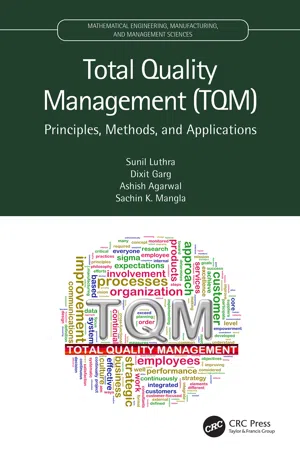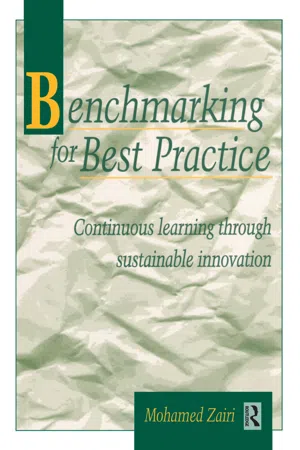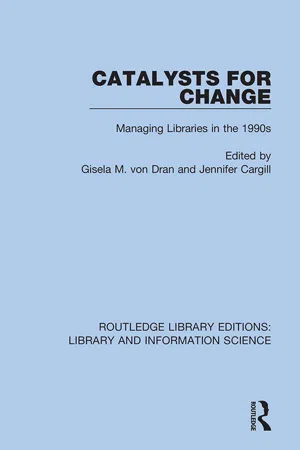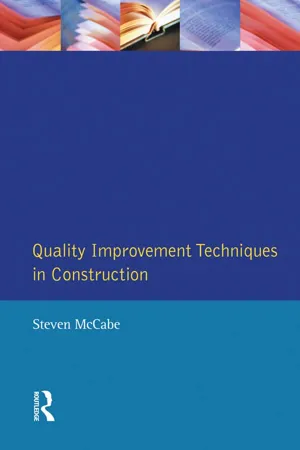Business
Total Quality Management
Total Quality Management (TQM) is a management approach that focuses on continuous improvement, customer satisfaction, and employee involvement. It emphasizes the importance of quality in all aspects of an organization's operations and involves processes such as quality planning, control, and improvement to achieve higher levels of performance and customer satisfaction.
Written by Perlego with AI-assistance
Related key terms
10 Key excerpts on "Total Quality Management"
- eBook - ePub
Total Quality Management (TQM)
Principles, Methods, and Applications
- Sunil Luthra, Dixit Garg, Ashish Agarwal, Sachin K. Mangla(Authors)
- 2020(Publication Date)
- CRC Press(Publisher)
2 Total Quality Management (TQM)2.1 DEFINITION OF Total Quality Management (TQM)
Total Quality Management (TQM) seeks to integrate all organisational functions, such as marketing, finance, design, engineering, production, customer service, etc. to focus on meeting customer needs and organisational objectives.TQM is defined as:- Total = Made up of the whole.
- Quality = Degree of excellence of product/service provider.
- Management = Art of handling, controlling and directing.
TQM sees an organisation as a set of processes. It argues that organisations must strive to continually improve these processes by integrating the knowledge and experiences of workers. The simple goal of TQM is ‘To do things right, the first time, always.’ TQM is infinitely variable and adaptable. This management approach covers several areas, although it was originally applied to manufacturing operations. For several years, it has only been used in this field. From now on, TQM is identified as a generic management tool, which also applies to services (health and safety), industrial enterprises, and the public sector. There is a series of evolutionary units, with different sectors creating their own versions of the common predecessor.Total Quality Management is also defined as a customer-driven process and goals for continuous improvement of business operations. It ensures that all related work (in particular the work of the employees) is directed towards the common objectives of improving the quality of the product or the quality of the service, as well as the production or execution process of the services. However, the focus is on evidence-based decision-making, with the use of performance measures to monitor progress (Deming). - eBook - ePub
Total Quality Management
Text, Cases, and Readings, Third Edition
- Joel E. Ross(Author)
- 2017(Publication Date)
- Routledge(Publisher)
1 INTRODUCTION TO Total Quality ManagementTotal Quality Management (TQM) is the set of management processes and systems that create delighted customers through empowered employees, leading to higher revenue and lower cost.J. M. Juran, quality expertTotal Quality Management (TQM) is the integration of all functions and processes within an organization in order to achieve continuous improvement of the quality of goods and services. The goal is customer satisfaction.Of all the management issues faced in the last decade, none has had the impact of or caused as much concern as quality in American products and services. A report by the Conference Board indicates that senior executives in the United States agree that the banner of total quality is essential to ensure competitiveness in global markets. Quality expert J. M. Juran calls it a major phenomenon in this age.1 This concern for quality is not misplaced.The interest in quality is due, in part, to foreign competition and the trade deficit.2 Analysts estimate that the vast majority of U.S. businesses will continue to face strong competition from the Pacific Rim and the European Economic Community for the remainder of the 1990s and beyond.3 This comes in the face of a serious erosion of corporate America’s ability to compete in global markets over the past 20 years. As we come to the end of the 20th century, the competitive and trade deficit problems are compounded by the weakening situation in Asian and other global markets. To compete in these markets may require additional efforts in both cost reduction and quality.The problem has not gone unnoticed by government officials, corporate executives, and the public at large. The concern of the president and Congress culminated in the enactment of the Malcolm Baldrige National Quality Improvement Act of 1987 (Public Law 100–107), which established an annual United States National Quality Award. The concern of business executives is reflected in their perceptions of quality. In a 1989 American Society for Quality Control (ASQC) survey, 54 percent of executives rated quality of service as extremely critical and 51 percent rated quality of product as extremely critical.4 - eBook - ePub
- Larry Webber, Michael Wallace(Authors)
- 2011(Publication Date)
- For Dummies(Publisher)
Continuous quality improvement: This concept means that every worker in the company feels empowered to improve his or her individual processes and is encouraged to recommend changes to larger processes. Each person takes ownership in order to make products right the first time and to stop bad products from reaching the end of the line.In this chapter, we cover the basic principles and steps of Total Quality Man- agement and the techniques and tools your company needs to get started. We also introduce the roles of different folks in TQM and show you how to keep the quality process working continuously.Total Quality Management in a Nutshell
Total Quality Management (TQM) is a company-wide, proactive effort to improve quality. Total means that all business functions (engineering, production, marketing, and so on) focus on defining and fulfilling (the ever-shifting) customer needs. Each company tailors TQM to fit its circumstances. The unifying theme is to “do the right things, the right way, the first time.”TQM is a result of earlier quality innovations from such eminent experts as W. Edwards Deming, Joseph Juran, Philip B. Crosby, and Kaoru Ishikawa. Like all great ideas, it combines the best techniques of each innovator into a “total” program. TQM was the first quality system that taught businesspeople to look to the process steps in order to improve. One of its greatest improvements was the realization that quality had to be moved out of the back office and into everything an organization does.In the following sections, we explain TQM’s principles, steps, pros, and cons.The guiding principles
Total Quality Management requires your company executives’ ongoing commitment to change. Rather than being the duty of a “quality department” in some distant, dark back room, quality improvement becomes everyone’s business. To be considered total, quality has to permeate all levels of the organization. Here are the TQM principles:Management commitment: - eBook - ePub
Construction Management
New Directions
- Denny McGeorge, Patrick X. W. Zou(Authors)
- 2012(Publication Date)
- Wiley-Blackwell(Publisher)
Of all of the concepts outlined in this book, TQM is one of the broadest and most wide ranging. In some ways it is an umbrella under which many other concepts are encompassed. As with other concepts in this book, there is no single accepted definition of TQM. Rampsey and Roberts [8], define TQM as:… a people focused management system that aims at continual increase in customer satisfaction at continually lower real cost. TQM is a total system approach (not a separate area or program), and an integral part of high level strategy. It works horizontally across function and department, involving all employees, top to bottom, and extends backwards and forwards to include the supply chain and the customer chain.(Interestingly, the construction industry invariably uses the word ‘client’ as opposed to ‘customer’ to describe a purchaser of good services, perhaps on the basis that ‘client’ has more sophisticated connotations than ‘customer’. In Webster’s Dictionary [9], these words are given as synonymous with one another.)In our view Rampsey and Roberts’ definition encompasses the fundamental principles of TQM. First, TQM must be a total approach to quality. Whereas in the past quality was concerned with parts of the organisation, such as the final product or customer relations, TQM is concerned with the whole system as an integrated unit. Second, TQM is ongoing. Whereas in the past quality was viewed as a system that could be put in place to improve certain sections of the product or organisation, TQM is a continuous process. The view is now taken that, however good a system has become, it can always be improved further. Finally, the goal of TQM is customer satisfaction. In the past, quality systems have been aimed towards improving products, not customer satisfaction. These are not necessarily the same thing, since it is possible to improve a product without realising that it is not in fact what the customer wants. - eBook - ePub
- Jens J. Dahlgaard, Ghopal K. Kanji, Kai Kristensen(Authors)
- 2008(Publication Date)
- Routledge(Publisher)
Introduction to Quality Engineering, American Supplier Institute, Dearborn, Michigan, USA.Passage contains an image
4 Philosophy, priniciples and concepts of TQM
TQM is a vision which the firm can only achieve through long-term planning, by drawing up and implementing annual quality plans which gradually lead the firm towards the fulfilment of the vision, i.e. to the point where the following definition of TQM becomes a reality:A corporate culture characterized by increased customer satisfaction through continuous improvements, in which all employees in the firm actively participate.Quality is a part of this definition in that TQM can be said to be the culmination of a hierarchy of quality definitions:- Quality—is to continuously satisfy customers’ expectations.
- Total quality—is to achieve quality at low cost.
- Total Quality Management—is to achieve total quality through everybody’s participation.
TQM is no inconsequential vision. At a time when most domestic and overseas markets are characterized by ‘cutthroat competition’, more and more firms are coming to realize that TQM is necessary just to survive. Today, consumers can pick and choose between a mass of competing products—and they do. Consumers choose the products that give the ‘highest value for money’, i.e. those products and services which give the highest degree of customer satisfaction in relation to price. - eBook - ePub
- Mohamed Zairi(Author)
- 2010(Publication Date)
- Routledge(Publisher)
Emphasis is on innovation rather than productivity only as used to be the case in the past. Customers are more willing to pay for things they have asked for and need, rather than what is stacked up on shelves and made available to them in the marketplace.2.1.2 The culture of business
This concept, called quality management, has now been embraced by the business community in the West. It follows from the Japanese success in dominating world markets through the application of simple quality principles: continuous improvement, waste elimination, cost reduction, reliance on productivity and work structures that focus on the end customer through company-wide deployment.Total Quality Management is a global concept, understood in all corners of the globe. Systems such as ISO 9000 are applied in all countries, criteria such as the MBNQA are used for self-assessment universally, and customer satisfaction measurement is being done in a similar way. This reflects how widely spread the concept of TQM is, and this is acknowledged by people who have pioneered some of the concepts or who have championed organizations that have achieved superior performance standards under the banners of TQM.John J. Hudiburg[1 ]: previous chairman and CEO of Florida Power & Light, the first non-Japanese company to have won the Deming Prize in 1989. The Deming Prize is considered to be the first and perhaps most prestigious award of quality achievements. In his book, Winning with Quality, he concluded:The movement is truly world-wide; the number of companies using TQM to improve quality is so large and the momentum so great that management who ignore it run a grave risk regarding the future of their companies.Armand V. Feigenbaum[2 ]: a quality guru. He coined the phrase ‘Total Quality Control’ which has been used by the Japanese ever since. It was used in his book of the same name, published in 1951 and changed to Total Quality Management in the 1983 edition. He argues that:We are increasingly focusing on Total Management as opposed to Total Quality. It's the economics of the delivery mechanism – the costs of doing things badly as much as the costs of doing it well, ultimately measured by the customer. - eBook - ePub
Catalysts for Change
Managing Libraries in the 1990s
- Gisela M. von Dran, Jennifer Cargill(Authors)
- 2019(Publication Date)
- Routledge(Publisher)
Total Quality Management: A Mindset and Method to Stimulate Change Janet A. Mullen INTRODUCTION If you have not heard of Total Quality Management (TQM), you simply have not been paying attention. TQM has received wide notice in the United States in the last decade and public and private organizations alike are adopting this new approach to managing the process of improving themselves. Even universities, typically known to be skeptical about applying business concepts to higher education, have adopted the TQM model. The American Association for Higher Education (AAHE) began “paying attention” to TQM in 1989 (Marchese, 1992). Other academic professional associations have realized the importance and relevance of TQM to higher education. If you attended a professional meeting in the last year, chances are, TQM had a prominent place on the agenda, drew standing room only crowds, and may have been the focus of the keynote address of the guest speaker. Moreover, some academic professional associations have sponsored TQM-specific seminars for their members such as the National Association of College and University Business Officers (NACUBO) did in December 1991 and March 1992. Janet A. Mullen is Associate Director, Student Health, Arizona State University, Tempe, AZ. [Haworth co-indexing entry note]: “Total Quality Management: A Mindset and Method to Stimulate Change. ” Mullen, Janet A. Co-published simultaneously in the Journal of Library Administration (The Haworth Press, Inc. ) Vol. 18, No. 3/4, 1993, pp. 91–108; and: Catalysts for Change: Managing Libraries in the 1990s (ed: Gisela M. von Dran and Jennifer Cargill) The Haworth Press, Inc., 1993, pp. 91–108. Multiple copies of this article/chapter may be purchased from The Haworth Document Delivery Center [1-800-3-HAWORTH; 9:00 a.m.–5:00 p. m - eBook - ePub
Quality Improvement Techniques in Construction
Principles and Methods
- Steven Mccabe(Author)
- 2014(Publication Date)
- Routledge(Publisher)
According to the advocates of TQM, leadership is axiomatic. It is regarded as one of the most essential elements. Stahl is typical of those who promote TQM when he states:Others reinforce this belief. Bell, McBride and Wilson explain that:Leadership is especially important in Total Quality Management because TQ involves dramatic change to a new and improved way of doing business and managing operations. It takes influential leaders to cause followers to change. (1995:302)Dale and Cooper in no uncertain terms believe that:Recent evidence indicates that organisations succeed or fail in their desire for positive management of quality in direct proportion to the amount of visible commitment from senior management level. (1994:189)Without the total commitment of the CEO [chief executive officer] and his or her immediate executives and other senior managers [presumably the quality manager in particular], nothing much will happen and anything that does will not be permanent. They must take personal charge and exercise forceful leadership. (1992:20)But what is meant by the term leadership , and how can it be implemented to ensure a TQ initiative will be successful in any organisation?9.3 THE MEANING OF LEADERSHIP
Attempting to define the term leadership is not easy. Indeed, Charles Handy (1976:93) has been moved to state that ‘the search for the definitive solution to the leadership problem has proved to be another endless quest for the Holy Grail in organization theory.’ Thomas (1993:109) goes even further, ‘Although [leadership] is a subject that has attracted a great deal of attention and … has spawned a voluminous literature, it remains one of the most confused areas in the whole field of management.’This does not bode well for understanding what leadership is, and how it can be applied to TQM. However, despite the problems, it is worthwhile to at least consider the available theories and what they might offer.9.3.1 Qualities or traits
This is the belief that leaders are born with certain characteristics. It is these characteristics which give them the skills to be effective leaders. People with such traits are able to influence others to act in accordance with their wishes. Six key traits have been identified by Kirkpatrick and Locke (1991:48–60): - eBook - ePub
Construction Project Management
A Practical Guide for Building and Electrical Contractors
- Eddy Rojas(Author)
- 2009(Publication Date)
- J. Ross Publishing(Publisher)
The only standard that employees and craftsworkers should be judged by is the quality of their work. Quality of work, however, should not be construed as merely the goodness of the end product. Quality of work both in the office and in the field needs to include not only the fitness of the end product for use by the customer, but also the timeliness and cost effectiveness of the effort. Arbitrary deadlines, budgets, and production rates have no place in judging the quality of work.Increase Worker PrideEmployees and craftsworkers in the contracting industry take pride in their work and want to do a quality job. Upper management must make sure that the business and production processes do not remove pride of workmanship or stifle the desire to do a quality job. In the field, the removal of unsupportive and poor craft supervision, the elimination of defective and inferior materials and installed equipment, and the removal of tools and production equipment that are not in working order or calibrated will go a long way toward increasing worker pride. Providing the employee and craftsworker what is needed to do a job when it is needed will allow the employee to focus on getting the job finished. Focusing on meeting the workers’ needs will result in improved quality and increased worker pride.Institute Total Quality Control EducationEmployees and craftsworkers must receive training in TQM just as they receive continuous training on the technical aspects of their job. TQM education introduces the employee and craftsworker to the concepts and skills necessary to implement TQM in their work. This includes imparting knowledge about continuous improvement as well as interpersonal skills to improve communications throughout the organization. The employee and craftsworker must understand the importance of quality, implementation of continuous improvement, and measurement of results to the ongoing success and growth of the contracting firm.Take ActionManagement must take action if a TQM program is to be successfully implemented. This action must be in accordance with the firm’s mission statement and strategic plan and include Deming’s 14 points. A plan without action is of no value.Developing a Quality Policy
Policy is a guide to managerial action. Part of management’s commitment to TQM is the formulation and communication of a quality policy. The quality policy should alert employees to the fact that management is serious about quality. To be effective, the quality policy should be drafted and disseminated by top management. - eBook - ePub
Total Quality Management in Higher Education
Study of Engineering Institutions
- Sayeda Begum, Chandrasekharan Rajendran, Prakash Sai L., K. Ganesh, Sanjay Mohapatra(Authors)
- 2020(Publication Date)
- Routledge India(Publisher)
3Total Quality Management in engineering educational institutions Framework and dimensions of TQM explainedThe conceptualization of quality with respect to all facets (structure, processes, and outcome) has always been a topic of discussion associated with engineering educational institutions (EEIs). This book provides a holistic framework addressing all the aspects of quality, and each of the TQM dimensions is explained in the chapter. The studies highlight the various roles the management/leadership in HEIs need to be responsible for in creating a vision for quality and supporting the achievement of institutional effectiveness. A brief discussion of the current state of the art is provided in this chapter. Figure 3.1 provides the organization of Chapter 3 .Figure 3.1The organization of Chapter 3This book has attempted to identify the critical dimensions of TQM and the measures of performance with respect to the EEIs from the major stake-holders’ perspective. Three different questionnaires–for faculty members, students, and alumni – were designed using the identified TQM dimensions to get a holistic perspective of TQM practices in the EEIs.
Index pages curate the most relevant extracts from our library of academic textbooks. They’ve been created using an in-house natural language model (NLM), each adding context and meaning to key research topics.









